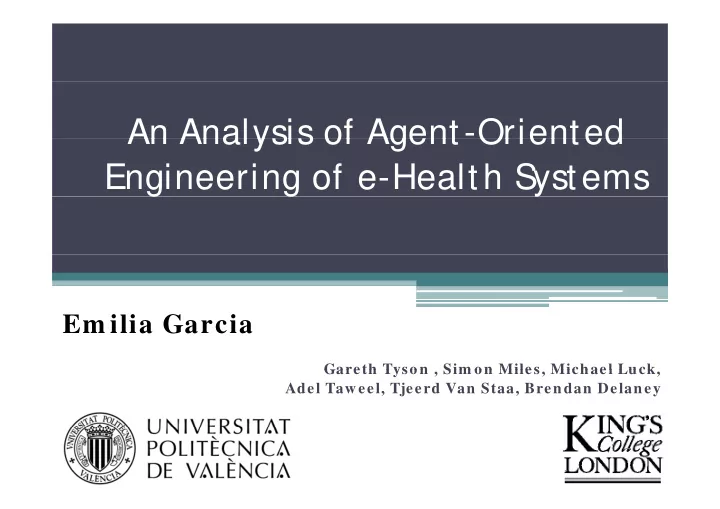

An Analysis of Agent-Oriented An Analysis of Agent Oriented Engineering of e-Health Systems g g y Em ilia Garcia Gareth Tyson Sim on Miles Michael Luck Gareth Tyson , Sim on Miles, Michael Luck, Adel Taweel, Tjeerd Van Staa, Brendan Delaney
To what extent is AOSE an approach h h that is appropriate to the development pp p p of e-health system s ?
Overview Overview • Analysis + case-study: Analysis + case study: ▫ e-Health system: ePCRN-IDEA Challenges in e-Health system development g y p ▫ AOSE methodology: ROMAS methodology • Discussion • Conclusions
e-Health system: ePCRN-IDEA e Health system: ePCRN IDEA Clinical trials are experiments by which the efficacy of medical treatments are explored. They involve recruiting patients with specific characteristics to undergo new treatments. Difficulty to find patients with these requirements Time restrictions. ePCRN-IDEA is a new system under deployment in the UK ePCRN IDEA is a new system under deployment in the UK healthcare system to enable real-tim e recruitm ent of patients for clinical trials.
Ph Phase 1: Create and distribute clinical trial 1 C t d di t ib t li i l t i l • Research body creates a new clinical trial injecting it through y j g g a service called the Central Control Service (CCS) ▫ CSS is hosted at King's College London (KCL). ▫ The CCS stores trials within a large database in a pre-defined format that all researchers must adhere to. • Associated with each trial is a list of potentially eligible A i t d ith h t i l i li t f t ti ll li ibl patients ▫ These lists are generated by the General Practice Research Database g y (GPRD) • The trials and their eligibility lists are distributed to software h i l d h i li ibili li di ib d f agents (called LEPIS agents ) that operate on clinicians' PCs at each participating clinic.
Ph Phase 2: Real-time eligible patients detection 2 R l ti ligibl ti t d t ti • During consultations LEPIS agents compare the patient information against the eligibility lists of all known trials. • If a patient is found to be eligible for a trial, ▫ The GP is notified ▫ If the patient is interested, the system loads a Random Clinical Trial (RCT) website allowing the patient's recruitment to be completed completed.
e-Health system: ePCRN-IDEA e Health system: ePCRN IDEA • The following organizations are involved: g g ▫ The research bodies Create clinical trials ▫ King´s College of London (KCL) Store trials in a pre-defined format Update clinic´s software information about trials and eligible Update clinic s software information about trials and eligible patients ▫ General Practice Research Database (GPRD) ( ) Create list of potential eligible patients ▫ Participating clinics Real-time patient´s information Direct contact between GP and patients
Challenges Challenges • Integration of Independent Systems. g p y ▫ Distributed Data ▫ Interoperability (techniques, processes, semantics) ▫ Trustworthiness • Regulation of Independent Systems • System Evolution. ▫ New legislation, software and medical techniques ▫ Adherence of new clinics
ROMAS ROMAS methodology methodology • Regulated Open Multi-Agent Systems Regulated Open Multi Agent Systems ▫ heterogeneous and autonomous agents ▫ that coexist in a complex social and legal framework ▫ that address conflicting objectives of the many stakeholders th t dd fli ti bj ti f th t k h ld involved.
ROMAS ROMAS overview overview Social structure and coordination Normative context: ◦ Norms ◦ Contracts ◦ Contracts Social contracts Contractual agreements
ePCRN IDEA with ROMAS ePCRN-IDEA with ROMAS Challenges AOSE concepts Integration of Independent Systems Integration of Independent Systems Organizations roles agents Organizations, roles, agents - Distributed data Organizations, agents -Interoperability Services -Trustworthines T t thi C Contracts, norms t t Regulation of independent systems Norms and social contexts System evolution Services, contracts, norms
ePCRN-IDEA with ROMAS ePCRN IDEA with ROMAS
Discussion: Beneficial features of AOS Discussion: Beneficial features of AOS E E •Assumption of autonomy •Allowance for openness •Explicit norms •High level of abstraction concepts
Discussion Discussion • The integration of specific e-Health term inology in the AOSE design process would facilitate the g p comprehension of the domain experts. • Although AOSE covers the analysis and design phases, there are not specific guidelines for capturing good practices for medicine and healthcare. ti f di i d h lth
Conclusions Conclusions • The use of high level AOSE concepts , such as organizations, roles, services, norms and contracts, is beneficial to analyze y and design health systems. • The use AOSE techniques will produce flexible systems that can deal with the dynamics of the normative and technological d l i h h d i f h i d h l i l environment.
Future work Future work • Integrate e-Health terminology with AOSE methodology • Guidelines for capturing good practices for medicine and h healthcare l h
mgarcia@dsic.upv.es Emilia Garcia
Recommend
More recommend